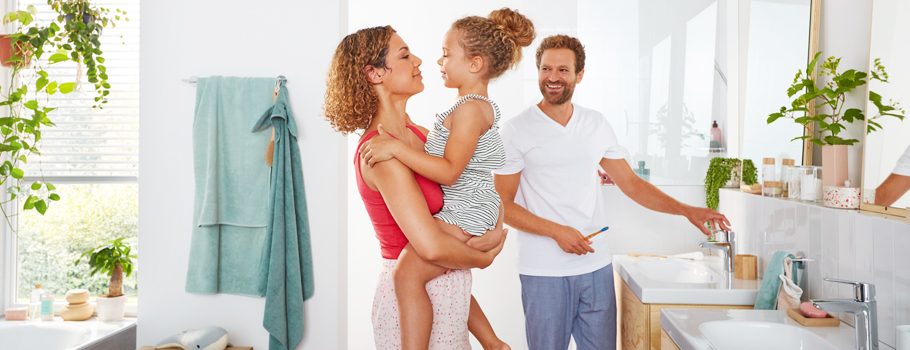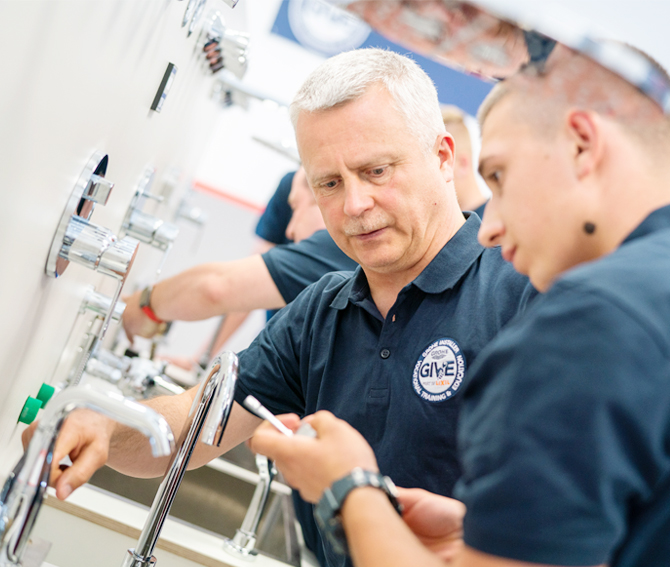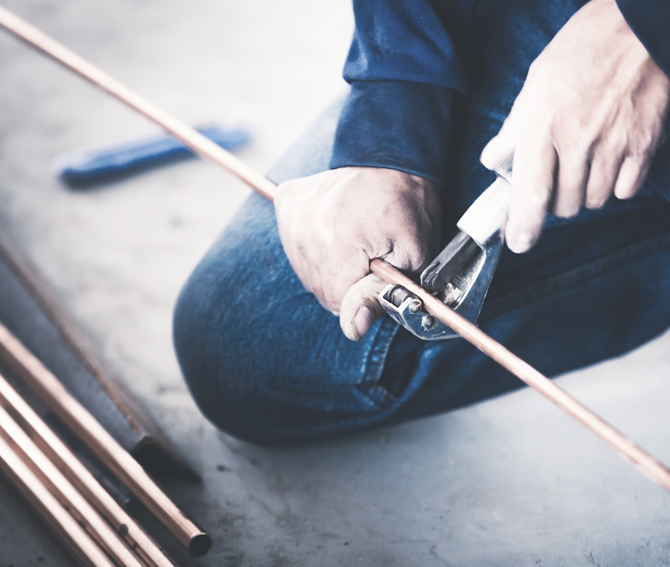LIXIL makes pioneering water and housing products that solve everyday, real-life challenges, making better homes a reality for everyone, everywhere.
- Global Site
-
- English
- Japanese
- Brand Sites
Global
- Global Site
-
- English
- Japanese
- Brand Sites

One of the unexpected effects of the pandemic was a meteoric rise in DIY.
The global home-improvement market grew by nearly 14% in 2020, with Europe taking a large share of this growth. In the UK, online sales of home-improvement and gardening products almost doubled as the first lockdown loomed.
This was partly driven by people spending much more time at home, but also by the difficulty of getting hold of plumbers and installers during lockdowns. Instead of waiting around, people turned their hand to DIY.
And despite the pandemic subsiding, the market appears set to keep growing, with experts predicting a compound annual growth rate of 3% between 2020 and 2025.
It appears that lockdowns only accelerated several developments that had already made themselves felt before COVID-19, and which the industry needs to address as a priority to set itself up for growth.
Jonas Brennwald, Leader of LIXIL EMENA, believes the sector faces some key challenges. Here he outlines three of them – and how they could be addressed.
1.REUNITING A POLARIZED INDUSTRY AND WINNING OVER YOUNG PEOPLE

One major issue that the heating and sanitary industry has struggled with for many years is a shortage of installers. A majority of professionals are now close to retirement and not enough young recruits are “in the pipeline”.
Contributing factors include a growing preference for higher education in the wake of the 2008 financial crisis – which, for some, has left plumbing with something of a stigma – and the demise of family plumbing businesses.
Adding to this, says Brennwald, are the long training periods and physical labor involved, which can be a turnoff for young people. The pandemic may have also influenced career choices, with research showing that jobseekers favor roles that allow them to work from home over in-person positions.
While this staffing shortage affects the whole sector, it is sanitary installers who are feeling it the most. Brennwald believes this reflects a polarization within the heating and sanitary industry. There is a sense that the sanitation segment has been “left behind” compared with heating. This is because policymakers and homeowners have focused much more on heating as they look to make homes more energy-efficient and less carbon intensive.
Statistics support this view: in the fourth quarter of 2021, an industry survey from marketing consultancy USP shows that there is a pronounced gap in large European markets. Roughly nine out of 10 companies in the UK, France and Poland perform heating installations, while only seven in 10 install sanitary ware.
“You can change your home energy source to solar panels or a ground-source heat pump very quickly, with tax incentives and public funding,” Brennwald says. “For that reason, installers are much more up to speed with these technologies than with the sanitary side of our industry.”
Similarly, installers – especially those newly coming into the industry – are attracted more by new net-zero technologies than by sanitary equipment. That is even though the sanitary sector is just as advanced and innovative with its products, Brennwald explains – it is just not as effective at telling that story.
2.OVERCOMING A FOCUS ON PROCUREMENT AND PRICE
“A newly erected apartment building today will effectively still have the same sanitary infrastructure that was common back in the 1980s,” Brennwald says.
The main reason for this is that the sanitary industry remains driven by procurement, with price rebates determining which products are made available to installers.
As a result, sanitary fittings continue to be sold as products rather than as part of solutions. There is little consulting as to the best, most energy-efficient, or water-conserving solutions for homeowners, Brennwald says.
“A typical floor-standing toilet uses seven to eight liters of water in each flush. Typically, in a household of four, the toilet is flushed 20 times a day. That is 140 liters of fresh water.”

While Europe is generally seen as a leader in sustainability and energy efficiency, Brennwald points to countries including the United Arab Emirates and Saudi Arabia as having introduced forward-looking laws to enforce sustainability in the sanitary domain.
“We need to form a united way of looking at sanitary in the same way as we do for heating. You will not attract more plumbers to sanitation without building a reputation for the industry of helping make our homes and infrastructure more sustainable and future-oriented.”
This also extends to boosting training and qualifications in modern sanitary technology to make the area as attractive as heating.
3.CREATING AN AGENDA FOR THE FUTURE
Brennwald urges the sanitary industry to embrace fundamental change in order to stay relevant to its markets.
A case in point is LIXIL brand GROHE’s introduction of its QuickFix portfolio. QuickFix products are designed to help homeowners do their own – simple – repairs when they can’t get hold of a plumber or the job is simply too small to require one.

Despite an overwhelmingly positive response from consumers, some in the sanitary industry are concerned about how this kind of consumerization will affect the installation market.
“But we have to be serious and say that a plumber will not go to a home to install a single faucet,” Brennwald points out.
He sees an opportunity for sanitary installers to become consultants who develop and install future-proof solutions for their customers – a job that requires an expert and that a DIY kit could never fulfill. This means that professionals could focus on more profitable, future-oriented projects, rather than low-paying tap replacements.

Instead of fighting the trend, says Brennwald, the industry and its professional bodies should “trade up” and develop an agenda for the future that positions them at the cutting edge of environmental and sustainability issues. These include areas such as water conservation, digitalization, and developing more sustainable sanitary infrastructure.
“We need to pull together as an industry – installers, suppliers, wholesalers, retailers, and industry bodies – to make our industry attractive again for both future talent and for our customers to want to work with us.”
Our Stories
- Backing People and Passions to Drive Innovation
- How Toilets in Schools are Catalyzing Change in Communities
- Building the Future by Recycling the Past
- Reinventing Consumer Connections in the World's Largest E-commerce Market
- Tackling Household Water Inefficiency in a Water-Stressed World
- Plugging the Plumber Shortage
- Pioneering Solutions to a Sewage Crisis in Rural Alabama
- Meet the Citizen Developers Changing How We Work
- Design and Brand Identity Transformation at LIXIL
- Three Changes to Prepare Europe’s Sanitary Industry for Growth
- Three Steps to Creating an Inclusive Culture
- From Linear to Circular: Giving Products in Your Home a New Lease of Life
- Crafting Unique Experiences as well as Products
- GROHE X: A Digital Brand Experience
- Design-led Innovation Delivering True Value
- Responsible Use of Plastics
- Empowering our People for an Agile Future
- Turning the Waves of Change into Opportunities
- SATO Tap: a New Handwashing Solution for All
- New Ways of Working Take Flight at LIXIL
- INAX: Rituals of Water
- Refreshing our sanitation targets, standing firm on our commitments
- Developing Attractive and Differentiated Products
- Conserving Water: The New Normal
- Insulating For a Warmer and Healthier Home
- Open Kitchen, Open Communication
- Tackling Open Defecation in India
- Shaping the Future of Faucets, One 3D Layer at a Time
- Bathed in Culture and Tradition
- Remodeling the Housing Market
- LIXIL's AQUA CERAMIC makes bathroom stains a thing of the past
- The Technology of Water
- Tackling Challenges in Global Sanitation and Hygiene
